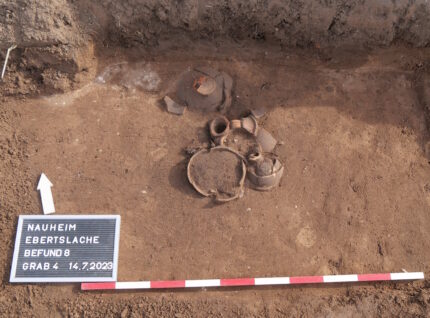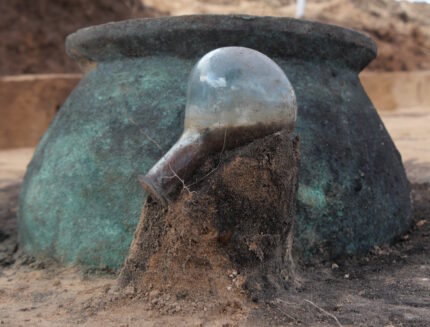A team of student and professional archaeologists have unearthed dozens of burials near
Nauheim, a town southwest of Frankfurt in the west central German state of Hesse. The grave goods indicate the deceased were immigrants with Gallic  funerary customs who settled in the area in the middle of the 1st century A.D.
funerary customs who settled in the area in the middle of the 1st century A.D.
The burial ground was discovered in a six-week salvage operation to recover any archaeological materials at the site before they were destroyed by intensive agricultural work and soil deterioration. A Roman military camp was known to have been built in the Nauheim area, so the team expected to find Roman remains. The graves of early settlers came as a surprise.
The Hessian Ried region of the Upper Rhine Plain was very swampy and sparsely populated in the 1st century. The general area was settled by the Germanic Chatti tribe in the 1st century B.C. If there was an indigenous Celtic population there, they left no archaeological evidence to speak of. In the 1st century A.D., the Roman army spread out from the large fort at Mainz to secure the Rhineland. As they always did, the Romans built roads and navigable waterways to enable the transportation of troops and supplies. Tribes moving south from northern Germany seeking greener pastures took advantage of the new Roman infrastructure, and rural settlements developed along the routes.
Archaeologists unearthed a total of 46 graves, 44 of them cremation burials, only two of them inhumations.
There are also six rectangular ditch systems that can be viewed as the enclosure of special burials and, according to current knowledge, all belong to the founding phase of the burial ground. In addition, the foundation of a tomb that was once many meters high was found, but in southern Hesse, which was poor in stone, it was completely dismantled in the Middle Ages and stripped of its stones right down to the base of the foundation. The burial ground can be traced back to the beginning of the 3rd century. The residents of a neighboring estate have used the area as a burial place for over 150 years. In some cases there are additions such as a complete urn made of glass, which testify to a certain level of prosperity of those buried. […]
One curious form of burial in particular stood out: an early Nauheimer “in the bucket”. Burying a person in a bronze bucket and providing tools such as scissors or knives is atypical for Roman burials. This is also the first time that evidence of the grave enclosures mentioned has been found in southern Hesse, while the custom was widespread on the left of the Rhine in the east of Gaul in the late Iron Age (1st century BC) and the 1st century AD. For scientists, such unusual burials are clear signs that immigrants were buried here, bringing not only their culture but also their burial rites with them.

“Humans, referred to as Romanes, walk the House” 😀
The spot is south of the river Main, in between Mainz (back then Mogontiacum) in the West and what today is Frankfurt. The ‘Upper Germanic-Rhaetian Limes’ runs down to Eining on the Danube.
From Mogontiacum there was a road to Nida of the Civitas Taunensium. Moreover, the site at Waldgirmes suggests a series of planned towns and market places founded by the Romans east of the Rhine and north of the Danube, aiming at long-term growth into population centres, but the complex was never completed.
A Celtic population can safely be presumed, as it was mainly Caesar, who had separated “Gaul”. In other words, there were Celts in the West, and Celts in the East, for example at the upper river Main at “Menosgada”, and further east, and e.g. in what today is Hessia at the Glauberg.
So to speak, there were movements –not only along the river Main– before the Romans.